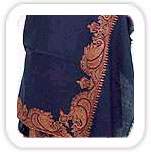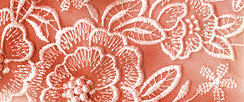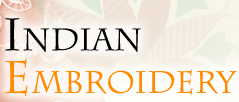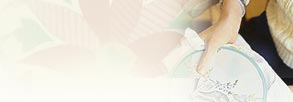
Kashmiri embroidery or kashida is colorful and beautiful as Kashmir
itself. Embroiders often draw inspiration from the beautiful nature
around. The colors the motifsof flowers, creepers and chinar leaves,
mango etc. are the most common ones. The whole pattern is created using
one or two embroidery stitch styles.
Process and Stitches
The base cloth whether wool or cotton, is generally white or crème
or other similar shades. Pastel colors are also often used. The
craftsmen use the color shades often blending with the background.
Thread colors are florals seen around. Very few stitches are used on one
fabric, one or two. Attimes the whole fabric is done in a single stitch
type. These stitches are often called Kashmiri stitch.
Kashmiri embroidery is known for the skilled execution of a single
stitch. Chain stitch, satin stitch, the slanted darn stitch, stem,
herringbone and sometimes the doori or knot stitches are used but not
more than one or two at a time.
Sozni embroidery or dorukha is often done so skillfully that the motif
appears on both sides of the shawl each side having a different color.
There is no wrong side. The same design is produced in different colors
on both sides.
Another type of needle embroidery is popularly known as 'papier mache'
embroidery because Flowers and leaves are worked in satin stitch in
bright colors such as those of papier mache and each motif is then
outlined in black. This is done either in broad panels on either side of
the breadth of a shawl, or covering the entire surface of a stole.
A third type of embroidery is ari or hook embroidery; motifs here are
the well-known flower design finely worked in concentric rings of chain
stitch. This is same as colored Zari or ari embroidery.





